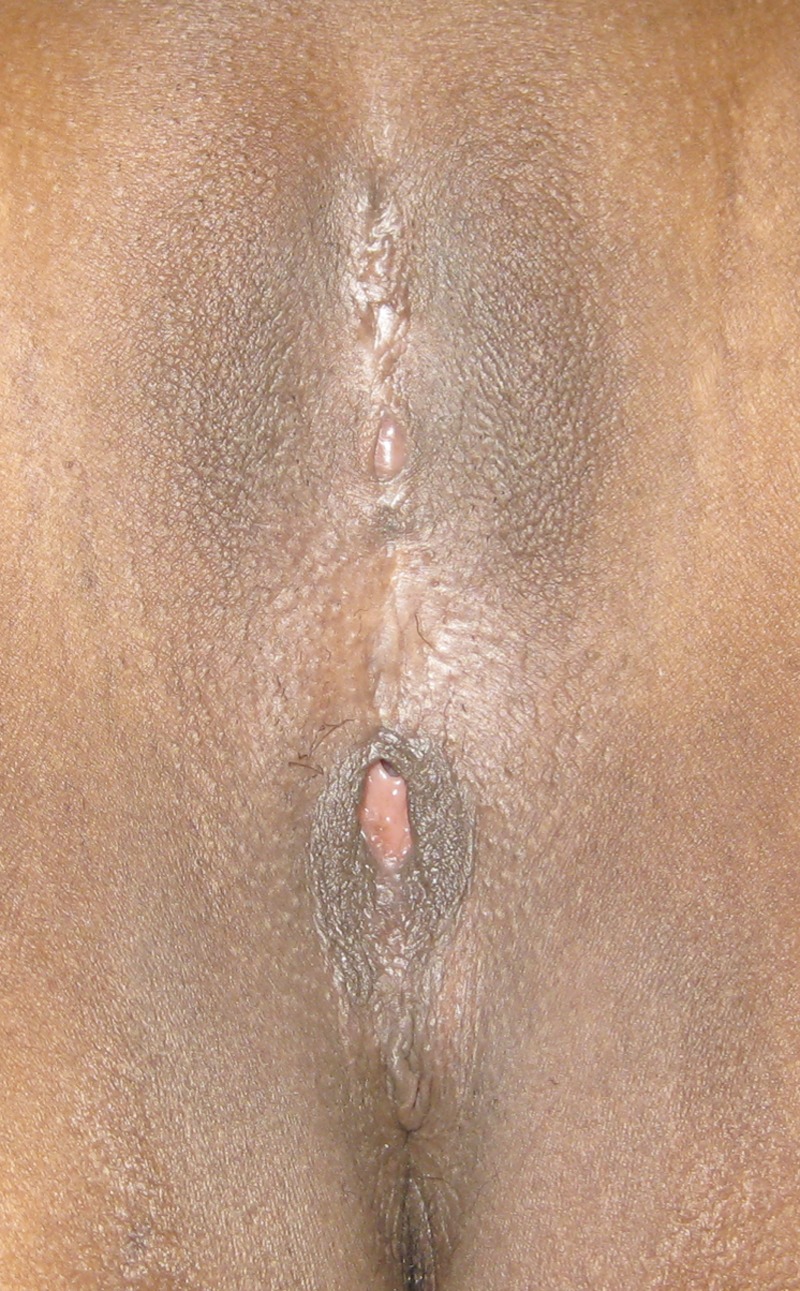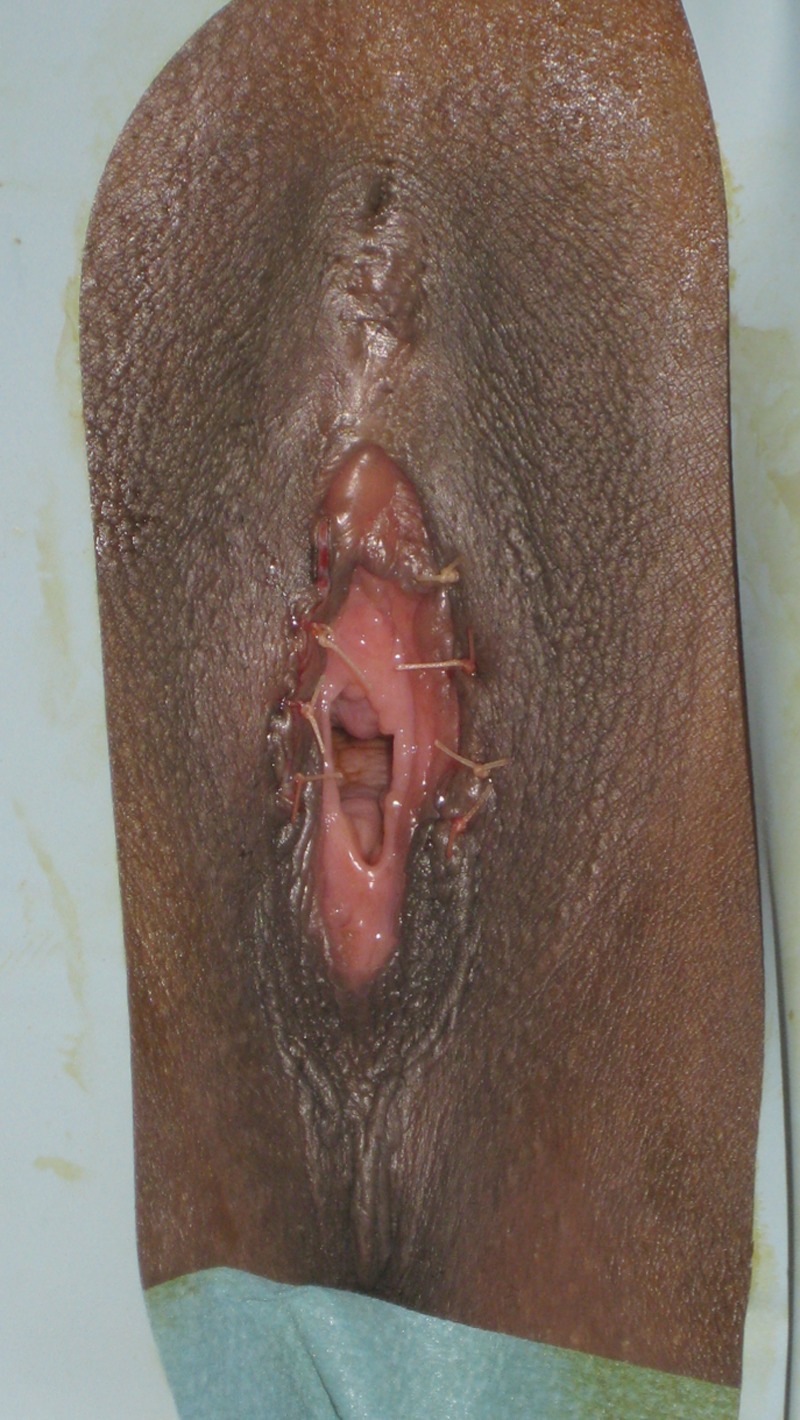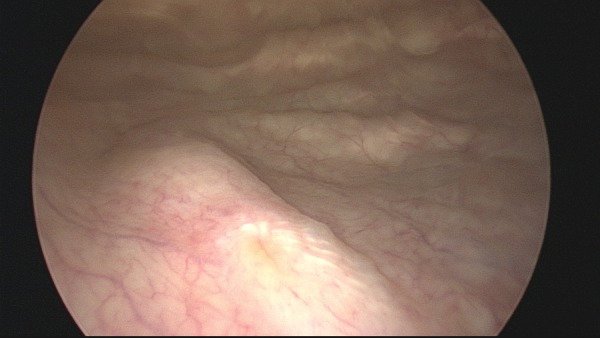Abstract
A 27-year-old Somali woman with type III a–b female genital mutilation/cutting, consulted because of slow micturition, voiding efforts, urgency and urge incontinence (overactive bladder). She also referred primary dysmenorrhoea and superficial dyspareunia making complete sexual intercourses impossible. We treated her by defibulation and biofeedback re-educative therapy. We also offered a multidisciplinary counselling. At 5 months follow-up, urgency and urge incontinence had resolved and she became pregnant.
Background
The possible short-term and long-term medical and psychological consequences of female genital mutilation/cutting (FGM/C) are various and well described. Late complications are often seen in Western countries. They depend on the conditions and modalities in which the practice was performed, the health and nutritional status of the child and, most of all, the type of mutilation.1 Type III, also called infibulation (table 1), is often the most severe one.
Table 1.
Classification WHO 20075
| Type I: partial or total removal of the clitoris* and/or the prepuce (clitoridectomy) | Type Ia: removal of the clitoral hood or prepuce only |
| Type Ib: removal of the clitoris* with the prepuce | |
| Type II: partial or total removal of the clitoris* and the labia minora, with or without excision of the labia majora (excision) | Type IIa: removal of the labia minora only |
| Type IIb: partial or total removal of the clitoris* and the labia minora | |
| Type IIc: partial or total removal of the clitoris*, the labia minora and the labia majora | |
| Type III: narrowing of the vaginal orifice with creation of a covering seal by cutting and appositioning the labia minora and/or the labia majora, with or without excision of the clitoris (infibulation) | Type IIIa: removal and apposition of the labia minora |
| Type IIIb: removal and apposition of the labia majora | |
| Type IV: unclassified | All other harmful procedures to the female genitalia for non-medical purposes, for example, pricking, piercing, incising, scraping and cauterisation |
*Notice that when total removal of the clitoris is reported, it refers to the total removal of the external part of the body of the clitoris.7
The main long-term complications of FGM/C type III are dysmenorrhoea, recurrent vaginal infections, dyspareunia, vulvar cysts, obstetric complications and urinary complications, such as slow micturition, recurrent urinary infections, drop by drop/prolonged micturition, dysuria,1 stagnation of the urine behind the scar with formation of stones2 and incomplete bladder emptying.3 Urinary incontinence and overactive bladder (OAB) are listed as possible long-term complications of infibulation1 but no case has been reported until today. This is the first documented case of OAB post FGM/C type III, a very distressing condition, probably under-reported due to shame, poor medical reception and cultural barriers.
Case presentation
A 27-year-old nulligravida Somali woman with no relevant medical and gynaecological history presented at our outpatient's clinic for women with FGM/C because of slow micturition, voiding efforts, urgency and urge incontinence (OAB). These symptoms were associated with primary dysmenorrhoea and superficial dyspareunia making it impossible to have complete sexual intercourses. She had been infibulated at the age of 11 years in a rural setting. The urinary symptoms became worse during the past 5 years and significantly affected her daily life. She had been living in Europe for more than 5 years and mentioned having consulted a gynaecologist some years ago, but no treatment had been proposed. She added that she had felt uncomfortable because the physician did not seem familiar with FGM/C. After that experience, she never consulted again in spite of worsening symptoms. It was after she married that she decided to see a physician again, because of her strong desire for a pregnancy. After having had painful first attempts of penetration, she wanted her infibulation to be surgically opened to start having complete sexual intercourse. Her husband agreed with her decision and was supportive.
Investigations
Following current recommendations on OAB,4 evaluation consisted of medical history, clinical examination, and vaginal and urine cultures. A general physical examination was normal. Her body mass index was 23. Vulvar inspection revealed a type III a–b FGM/C according to the WHO classification, corresponding to the narrowing of the vaginal orifice with creation of a covering seal by cutting the labia majora and the labia minora and apposition of the labia minora5 (table 1). The scar of infibulation presented two small holes of 2 and 5 mm, respectively from which urine and menstrual blood could flow (figure 1). The palpation of the scar was not painful and vulvar trophicity was normal. The clitoral tissue was well palpable under the scar and part of the clitoral glans was visible through the superior opening (figure 1). Urinary and vaginal cultures, Chlamydia trachomatis and Neisseria gonorrhoeae PCR tests and blood tests (including kidney function) were normal.
Figure 1.

Female genital mutilation/cutting type IIIa–b (infibulation).
We asked our patient to fill a frequency/volume chart for micturition. She filled a frequency chart with on average 10 micturitions/day and 5/night. She referred of fluid intake restriction during the last months because of her symptoms. She also reported embarrassment, a declining quality of life due to urge incontinence and urgencies, along with a deteriorating personal image.
At our gynaecological outpatient's clinic for women with FGM/C, the patient received detailed information about female anatomy, physiology, FGM/C and surgery. She also agreed to see our psychiatrist specialised in sexology, as well as our reproductive and sexual health counsellor, part of our multidisciplinary team. Her personal history revealed treatment and psychiatric follow-up for depression and post-traumatic stress disorder post migration from Somalia to Europe. There was no present psychiatric disorder.
No translator was needed during the entire follow-up of the patient.
Treatment
Defibulation (surgical technique that exposes the vaginal opening, the urethral meatus (partial defibulation) and the remaining clitoral tissue (total defibulation)) was proposed and accepted by the patient (figure 2), along with cystoscopy due to her urinary symptoms. Cystoscopy revealed thick trabeculae, hyperaemia and petechias, compatible with OAB (figure 3). There were no intraoperative complications.
Figure 2.

Female genital mutilation/cutting type IIIa-b after defibulation. The urinary meatus, the clitoris and the hymeneal ring are visible.
Outcome and follow-up
The postoperative immediate follow-up was uneventful. At day 7 postoperation, the patient referred no more voiding efforts but persistent urgencies and urinary incontinence. A conservative management consisting in counselling and biofeedback was proposed. Follow-up was scheduled after completion of biofeedback. Further tests would be scheduled according to response to the treatment.
Figure 3.

Cystoscopy showing thick trabeculae, hyperaemia and petechias compatible with an overactive bladder.
The patient was compliant to biofeedback, started to have sexual intercourse and became pregnant 2 months after surgery. Biofeedback re-educative therapy consisting of nine weekly sessions was well tolerated and continued until the end of the first trimester of pregnancy. At the end of the biofeedback she had good proprioception of her perineum, more capacity to retain urine and did not experience urgency or urge incontinence any more. Her micturitions went from 10 to 6 during the day and 5 to 3 during the night. These values might have been lower had the patient not been pregnant.6
She was satisfied with the care offered and the results achieved and reported a strong improvement of her quality of life.
Discussion
FGM/C concerns all procedures involving partial or total removal of the external female genitalia or other damage to the female genital organs for non-medical reasons5 and can be associated with various psychosexual and medical long-term complications.7 This is the first case reported on clinically documented OAB due to FGM/C type III. Generally speaking, OAB is characterised as urinary urgency, with or without urge incontinence, usually with frequency and nycturia in the absence of causative infection.8 The pathophysiology can be neurogenic, myogenic or idiopathic.9 The symptoms are due to involuntary contractions (detrusor overactivity) of the detrusor muscle during the filling phase of the micturition cycle mediated by acetylcholine-induced stimulation of muscarinic receptors.8 A prolonged bladder outlet obstruction, in our case infibulation, can cause those myogenic, morphological and neurogenic changes which lead to detrusor overactivity.9
OAB can significantly reduce the quality of life of affected individuals, who are often too embarrassed or afraid to seek medical treatment.10 Its impact on quality of life and psychological well-being is determined by individual symptoms, its undertreatment and underdiagnosis.11 The undertreatment has been attributed to failure of the patient to seek treatment and of providers to inquire about urinary symptoms and/or treat them. Furthermore, patients with OAB often have low self-esteem, fear and embarrassment of the condition and seeking treatment. A poor reception for those who do seek treatment can exacerbate emotional distress and health-related quality of life impact for the patient.12 13 Our patient not only had OAB, but also a genital mutilation/cutting, which increased fear, embarrassment and distrust in medical professionals as well as poor reception due to the absence of expertise/experience of most physicians. In addition, women with FGM/C are not always aware of a symptom, which can be perceived as a ‘normal condition’. Our patient waited until getting married before asking for defibulation: her desire for pregnancy was a stronger motive than all her previous urinary symptoms, which had affected significantly her quality of life.
In the medical literature, we found few cases of labial fusion in adults, mostly during menopause, causing voiding difficulty,14 recurrent urinary tract infections,15 pseudoincontinence16 or urinary incontinence.17 They were successfully treated or alleviated by topic oestrogens or, more often, by surgical separation of the fusion, exactly as we did by defibulation in our patient. Relief of obstruction has been shown to be associated with the reduction of urinary frequency and reversal of these changes.17
After surgery, biofeedback re-education was part of the treatment of our patient. Initial treatment for OAB is usually conservative (behavioural interventions and teaching techniques to suppress urgency and improve continence skills). Antimuscarinic drugs are commonly used as second-line therapy for patients who are unresponsive to behavioural therapy.18
Defibulation is a simple surgery. It can vastly improve mutilated women's health by the resolution of symptoms, such as repeated urinary or vaginal infections, prolonged micturition, dysmenorrhoea and superficial dyspareunia.7 19 It also facilitates subsequent delivery and gynaecological screenings. However, though technically it is a simple surgery, it requires very special and complex care, as it implies cultural, physical and physiological changes: the patient may experience doubts, resistances or fear of exclusion from her own community/husband when she decides to open her scar. Therefore, the information and support given to the woman and her partner in the consultations before and after defibulation are of crucial importance. Furthermore, some ethnic groups can have traditional false beliefs about uncut and postdefibulation female genital anatomy. Some can imagine, for example that after defibulation the vaginal opening will be very large.7 Our patient referred that biofeedback promoted her perineal proprioception and also a better knowledge/awareness of her genital anatomy after defibulation.
FGM/C is frequently not reported by women during history or the type of FGM/C referred does not correspond to the real one. A regular examination is crucial to provide good medical care20 and avoid overlooking rare but simple reversible conditions.15 A careful genital examination is necessary to recognise and classify the type of FGM/C, exclude long-term complications, such as cysts, distinguishing infibulation from other kinds of labial fusion and propose appropriate treatment. Medical professionals should be trained in the diagnosis and care of complications of FGM/C. Multidisciplinary care should be offered, taking into account medical, cultural as well as psychological and sexual aspects.
As suggested, the treatment success implies improvements of symptoms, and thereby of quality of life, and fulfilling patient expectations and satisfaction.2,1 In our case, all these goals were reached. Our patient reported an improved quality of life, the reduction/resolution of her symptoms, complete unpainful sexual intercourses which led to her desired pregnancy.
Learning points.
Overactive bladder post female genital mutilation/cutting type III is a very distressing condition, probably under-reported due to shame, poor medical reception and cultural barriers.
Vulvar examination is crucial to provide good medical care.
Defibulation can solve the symptoms and improve the quality of life of the patient.
Biofeedback re-educative therapy can be prescribed after surgery.
Multidisciplinary and culturally competent care should be offered in association with surgery and re-educative therapy.
Footnotes
Contributors: JA was responsible for identification and management of the case, and contributed to conception and design, and drafted the article. JA and PD contributed to revision of the article and final approval of the version of the manuscript to be published.
Competing interests: None.
Patient consent: Obtained.
Provenance and peer review: Not commissioned; externally peer reviewed.
References
- 1.Population Reference Bureau Female genital mutilation/cutting: data and trends. http://www.prb.org/pdf08/fgm-wallchart.pdf (accessed 24 Oct 2012)
- 2.Nour NM. Urinary calculus associated with female genital cutting. Obstet Gynecol 2006;2013(2 Pt 2):521–3 [DOI] [PubMed] [Google Scholar]
- 3.Awang N, Viegas C, Viegas OAC. Incomplete bladder emptying due to labial fusion in a pubertal girl: a delayed consequence of female circumcision. Aust N Z J Obstet Gynaecol 2004;2013:372–3 [DOI] [PubMed] [Google Scholar]
- 4.Robinson D, Cardozo L. Overactive bladder: diagnosis and management. Maturitas 2012;2013:188–93 [DOI] [PubMed] [Google Scholar]
- 5.WHO Eliminating female genital mutilation: an interagency statement—UNAIDS, UNDP, UNECA, UNESCO, UNFPA, UNHCHR, UNHCR, UNICEF, UNIFEM, WHO. Geneva: World Health Organization, 2008 [Google Scholar]
- 6.Van Brummen HJ, Bruinse HW, Van de Pol G, et al. What is the effect of overactive bladder symptoms on woman's quality of life during and after first pregnancy? BJU Int 2006;2013:296–300 [DOI] [PubMed] [Google Scholar]
- 7.Abdulcadir J, Margairaz C, Boulvain M, et al. Care of women with FGM/C. Swiss Med Wkly 2011;2013:w13137. [DOI] [PubMed] [Google Scholar]
- 8.Haylen BT, de Ridder D, Freeman RM, et al. An International Urogynaecological Association (IUGA)/International Continence Society (ICS) joint report on the terminology for female pelvic floor dysfunction. Int Urogynecol J 2010;2013:5–26 [DOI] [PubMed] [Google Scholar]
- 9.Banakhar MA, Al-Shaiji TF, Hassouna MM. Pathophysiology of overactive bladder. Int Urogynecol J 2012;2013:975–82 [DOI] [PubMed] [Google Scholar]
- 10.Ouslander JG. Management of overactive bladder. N Engl J Med 2004;2013:786–99 [DOI] [PubMed] [Google Scholar]
- 11.Khullar V. Patient-reported outcomes and different approaches to urinary parameters in overactive bladder: what should we measure? Int Urogynecol J 2012;2013:179–92 [DOI] [PubMed] [Google Scholar]
- 12.Ballert KN. Under treatment of overactive bladder. J Urol 2010;2013:1282–3 [DOI] [PubMed] [Google Scholar]
- 13.Nicolson P, Kopp Z, Chapple CR, et al. It's just the worry about not being able to control it! A qualitative study of living with overactive bladder. Br J Health Psychol 2008;2013:343–59 [DOI] [PubMed] [Google Scholar]
- 14.Kucuk M, Halil S, Ocer F, et al. Labial fusion first diagnosed during pregnancy with voiding difficulty and its management: a case report. Clin Exp Obstet Gynecol 2011;2013:94–5 [PubMed] [Google Scholar]
- 15.Dirim A, Hasirci E. Labial fusion causing urinary incontinence and recurrent urinary tract infection in a postmenopausal female: a case report. Int Urogynecol J 2011;2013:119–20 [DOI] [PubMed] [Google Scholar]
- 16.Acharya N, Mandal AK, Ranjan P, et al. Labial fusion causing pseudoincontinence in an elderly woman. Int J Gynaecol Obstet 2007;2013:246–7 [DOI] [PubMed] [Google Scholar]
- 17.Palla L, De Angelis B, Lucarini L, et al. A case of labial fusion and urinary pseudo-incontinence in an elderly woman. A surgical treatment and a review. Eur Rev Med Pharmacol Sci 2010;2013:491–3 [PubMed] [Google Scholar]
- 18.Murphy AM, Krlin RM, Goldman HB. Treatment of overactive bladder: what is on the orizon? Int Urogynecol J 2013;2013:5–13 [DOI] [PubMed] [Google Scholar]
- 19.Teufel K, Dörfler DM. Female genital circumcision/mutilation: implications for female urogynaecological health. Int Urogynecol J. Published Online First: 16 Jul 2013. doi:10.1007/s00192-013-2160-5 [DOI] [PubMed] [Google Scholar]
- 20.Mahran MA, Oligbo N. Labial fusion causing urinary incontinence: comment. Int Urogynecol J 2011;2013:1335. [DOI] [PubMed] [Google Scholar]
- 21.Shah S, Nitti V. Defining efficacy in the treatment of overactive bladder syndrome. Rev Urol 2009;2013:196–202 [PMC free article] [PubMed] [Google Scholar]


